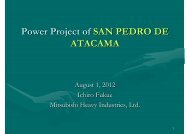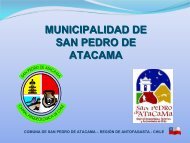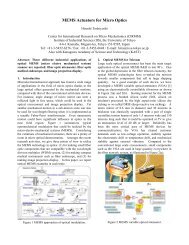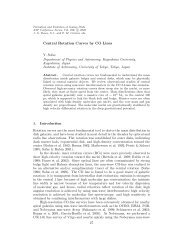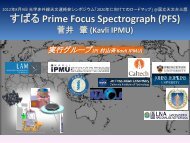Fabrication and tolerances of moth-eye structures for perfect ...
Fabrication and tolerances of moth-eye structures for perfect ...
Fabrication and tolerances of moth-eye structures for perfect ...
You also want an ePaper? Increase the reach of your titles
YUMPU automatically turns print PDFs into web optimized ePapers that Google loves.
transmittance [%]<br />
110<br />
100<br />
90<br />
80<br />
no gap space<br />
gap space<br />
No. 1<br />
No. 2<br />
70<br />
65<br />
10 20 30 40 50 60 70<br />
wavelength [µm]<br />
Figure 7. The result <strong>of</strong> simulation <strong>for</strong> flared models with <strong>and</strong> without gap space. The solid line (red) corresponds to the<br />
case without gap <strong>and</strong> the longest dashed line (green) with gap. The second longest (blue) represents the measurement <strong>of</strong><br />
No. 1 <strong>and</strong> the shortest (magenta) represents the measurement <strong>of</strong> No.2.<br />
The best sample has transmitted more than 98 % at the maximum <strong>and</strong> more than 96 % in the wide range <strong>of</strong><br />
20-50 µm. To investigate what made the spectra different, <strong>and</strong> why the transmittance did not reach more than<br />
99 % in the wide range, we have carried out a numerical analysis with RCWA. Consequently, we have acquired<br />
a few <strong>tolerances</strong> <strong>for</strong> fabricating <strong>moth</strong>-<strong>eye</strong> <strong>structures</strong>:<br />
1. The shape <strong>of</strong> the protuberances must be straight from the tops to the bottoms.<br />
2. The tops may be flat if the filling factor is a few percent.<br />
3. Gap space at the bottom must be as little as possible, that is, the porosity is less than 15 %.<br />
If the <strong>moth</strong>-<strong>eye</strong> structure can be made within the allowed <strong>tolerances</strong>, the transmittance <strong>of</strong> more than 99 % will<br />
be achieved.<br />
In the near future, <strong>moth</strong>-<strong>eye</strong> <strong>structures</strong> will be applied to both sides <strong>of</strong> silicon substrates <strong>and</strong> finally to silicon<br />
lens <strong>for</strong> mid-infrared instruments.<br />
ACKNOWLEDGMENTS<br />
We are grateful to NTT Advanced Technology Corporation <strong>for</strong> fabricating the <strong>moth</strong>-<strong>eye</strong> structure samples which<br />
meet our requirements. This work was supported by Grant-in-Aid <strong>for</strong> Young Scientists (A) 21740131 <strong>and</strong> Grant<br />
<strong>for</strong> development <strong>of</strong> on-board instruments from JAXA.<br />
REFERENCES<br />
[1] Nakagawa, T., “The next-generation space infrared astronomy mission SPICA,” in [Space Telescopes <strong>and</strong><br />
Instrumentation 2010: Optical, Infrared, <strong>and</strong> Millimeter Wave], Oschmann, J. M. J., Clampin, M. C., <strong>and</strong><br />
MacEwen, H. A., eds., Proc. SPIE 7731, 77310O–77310O–8 (2010).<br />
[2] Yoshii, Y., Aoki, T., Doi, M., H<strong>and</strong>a, T., Kawara, K., Kato, D., Kohno, K., Konishi, M., Koshida, S.,<br />
Minezaki, T., Mitani, N., Miyata, T., Motohara, K., Sako, S., Soyano, T., Tanabe, T., Tanaka, M., Tarusawa,<br />
K., Bronfman, L., Ruiz, M. T., <strong>and</strong> Hamuy, M., “The University <strong>of</strong> Tokyo Atacama Observatory 6.5m<br />
telescope project,” in [Ground-based <strong>and</strong> Airborne Telescopes III], Stepp, L. M., Gilmozzi, R., <strong>and</strong> Hall,<br />
H. J., eds., Proc. SPIE 7733, 773308–773308–9 (2010).<br />
[3] Edwards, D., “Silicon (Si),” in [H<strong>and</strong>book <strong>of</strong> Optical Constants od Solids], Palik, E., ed., 547–569, Academic<br />
Press (1985).







